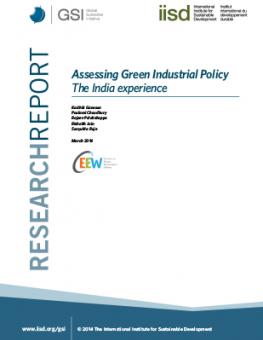
Assessing Green Industrial Policy: The India experience
This report is one in a series that considers the lessons for green industrial policy that can be learned from policies in the renewable energy sector. The aim of the series is to provide policy-makers with research to support the development of cost-effective, well-targeted policies for the development of green industries.
Green industrial policy (GIP) is the pursuit by governments of national economic excellence in key green economy sectors, with a view to creating globally competitive domestic firms.
It differs in only a few respects from traditional industrial policy, most significantly in regards to the potential global environmental benefit that comes from private sector innovation and competition in these areas.
GIP is increasingly used by governments in both developed and developing countries, a trend that is likely to be reinforced in coming years by the desire to capture the environmental and economic benefits of green economy sectors. However, as with traditional industrial policy, it is easy to implement policies that undermine rather than support the intended goals.
This report is one in a series that considers the lessons for GIP that can be learned from policies in the renewable energy sector. The aim of the series is to provide policy-makers with research to support the development of cost-effective, well-targeted policies for the development of green industries. The reports highlight how policies have worked, the outcomes of the policies and the lessons that have been learned.
This report focuses on the wind and solar sectors in India. It reviews Indian policies for raising the share of renewables in the energy mix within the context of multiple social, economic and technological objectives. Based on this analysis, the report concludes that “green” rather than “industrial” elements have been best supported by policy to date. Impacts are most clearly seen in energy security and access, avoided health costs and abatement of GHG emissions, while the industrial policy element has fared poorly in comparison. Marrying the two elements more completely will allow the benefits of a renewable energy manufacturing sector and environmental protection to be successfully realized.
View the other paper in this series, Stable Policies – Turbulent Markets The costs and benefits of promoting solar PV and wind energy.
You might also be interested in
Border Carbon Adjustment Mechanisms and Impacts on Vietnam
This report consolidates, analyzes, and presents views and perspectives of stakeholders from Vietnam on border carbon adjustment (BCA) schemes to contribute to the global debate on BCA good practices.
The Urgency and Complexity of Moving Beyond GDP
Efforts to explore how the portfolio of capitals that make up Comprehensive Wealth—financial capital, produced capital, natural capital, human capital, and social capital—can give policymakers insights into how their policies build wealth for their countries in the long run.
Out With the Old, Slow With the New
This report assesses progress made by Clean Energy Transition Partnership (CETP) signatories on shifting finance from fossil fuels to clean energy.
The United Kingdom's Strategy for Carbon Border Adjustment in a Changing Global Landscape
This report consolidates, analyzes, and presents views and perspectives of United Kingdom stakeholders on its proposed Carbon Border Adjustment Mechanism (CBAM) to contribute to the global debate on international principles and best practices for national border carbon adjustment schemes.